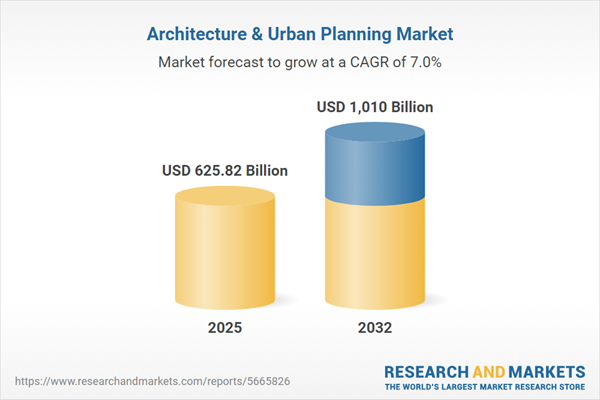Speak directly to the analyst to clarify any post sales queries you may have.
The Architecture & Urban Planning Market is entering a dynamic phase, shaped by accelerated technological advances, sustainability imperatives, and evolving global urbanization trends. As the built environment adapts to new regulatory and demographic landscapes, senior leaders must understand what is driving the sector's transformation to make informed decisions that support competitive and resilient growth.
Market Snapshot: Architecture & Urban Planning Market Growth Drivers
The Architecture & Urban Planning Market grew from USD 586.36 billion in 2024 to USD 625.82 billion in 2025. It is expected to continue growing at a CAGR of 7.03%, reaching USD 1.01 trillion by 2032. Market momentum is propelled by next-generation design technologies, green construction practices, and the rising need for adaptive, integrated solutions across increasingly complex urban environments. Alongside policy developments and disruptive global supply chain shifts, organizations are navigating rapid changes in project delivery methods and cross-disciplinary collaboration models.
Scope & Segmentation: Industry Overview and Emerging Segments
- Design Styles: Classical (Baroque, Gothic), Futuristic, Minimalist, Vernacular
- Building Materials: Concrete, Glass, Steel, Wood (Bamboo, Timber)
- Construction Techniques: Modular Construction, On Site
- Project Scales: Large-Scale, Mid-Small-Scale
- Building Types: Commercial (Office Spaces, Retail Buildings), Industrial (Manufacturing Plants, Warehouses), Institutional (Educational Facilities, Hospitals), Residential (Multifamily Housing, Single-Family Homes)
- Regional Coverage: Americas (North America: United States, Canada, Mexico; Latin America: Brazil, Argentina, Chile, Colombia, Peru), Europe, Middle East & Africa (Europe: United Kingdom, Germany, France, Russia, Italy, Spain, Netherlands, Sweden, Poland, Switzerland; Middle East: United Arab Emirates, Saudi Arabia, Qatar, Turkey, Israel; Africa: South Africa, Nigeria, Egypt, Kenya), Asia-Pacific (China, India, Japan, Australia, South Korea, Indonesia, Thailand, Malaysia, Singapore, Taiwan)
- Technology Integration: Generative design, parametric modeling, building information modeling, digital twins, sensor networks, Internet of Things
- Company Coverage: AECOM, Aedas, Autodesk, Bentley Systems, CityCAD Technologies, DLR Group, Foster + Partners, Gensler, Google/Alphabet, HDR, Hexagon AB, HKS, HOCHTIEF/ACS Group, HOK, IBI Group/Arcadis, Jacobs Engineering/WorleyParsons, Kohn Pedersen Fox, NBBJ, Nikken Sekkei, PCL Constructors, Perkins Eastman, Perkins&Will, Populous, SAP SE, Skidmore Owings & Merrill, SmithGroup, Stantec, TestFit, Trimble, ZGF Architects
Key Takeaways for Senior Decision-Makers
- Urban project delivery is increasingly reliant on data-driven modeling and collaboration frameworks, accelerating stakeholder alignment and improving risk management.
- Sustainability actions extend beyond regulatory compliance, with net-zero objectives and circular economy principles guiding both design and procurement decisions.
- Adaptive reuse, mixed-use developments, and community engagement are redefining priority investment areas within urban cores and adjacent growth corridors.
- Material innovation, especially in timber, low-carbon composites, and modular construction, is enabling faster, more resource-efficient project delivery while meeting performance benchmarks.
- Socioeconomic shifts and regional nuances are prompting a strategic focus on local context, social inclusivity, and climate resilience in both public and private initiatives.
- Integrated service offerings, combining feasibility assessment, digital prototyping, and post-occupancy evaluation, are becoming essential for preferred vendors and project partners.
Tariff Impact: Navigating Policy and Supply Chain Uncertainty
Recent tariffs on building materials—including steel, aluminum, glass, and composites—are reshaping global supply strategies. Many firms are diversifying supplier relationships, developing local production, and partnering with material science organizations to validate alternatives and achieve greater cost predictability. These actions help companies mitigate risks arising from policy shifts and protect operational budgeting continuity, demonstrating the importance of scenario planning at the executive level.
Methodology & Data Sources
This report synthesizes insights from in-depth interviews with industry professionals, site observations, academic and public research reviews, and rigorous quantitative analysis. Peer-reviewed by independent experts, it delivers reliable, actionable intelligence rooted in both qualitative and statistical validation.
Why This Report Matters
- Empowers business leaders to identify emerging growth opportunities and deploy innovative, sustainable project models with confidence.
- Provides granular competitive intelligence to inform strategic partnerships, technology adoption, and capital allocation across regional markets.
Conclusion
Senior leaders who align their strategy with new paradigms in architecture and urban planning are positioned for resilient growth and market leadership. This report offers practical, evidence-based guidance to navigate change and capture value in evolving built environments.
Additional Product Information:
- Purchase of this report includes 1 year online access with quarterly updates.
- This report can be updated on request. Please contact our Customer Experience team using the Ask a Question widget on our website.
Table of Contents
3. Executive Summary
4. Market Overview
7. Cumulative Impact of Artificial Intelligence 2025
Companies Mentioned
The companies profiled in this Architecture & Urban Planning market report include:- AECOM
- Aedas
- Autodesk, Inc.
- Bentley Systems, Incorporated
- CityCAD Technologies Limited
- DLR Group
- Foster + Partners
- Gensler
- Google LLC by Alphabet Inc.
- HDR, Inc.
- Hexagon AB
- HKS Inc.
- HOCHTIEF Aktiengesellschaft by ACS Group
- HOK Group, Inc.
- IBI Group Inc. by Arcadis NV
- Jacobs Engineering Group Inc. by WorleyParsons Ltd.
- Kohn Pedersen Fox
- NBBJ
- Nikken Sekkei Ltd.
- PCL Constructors Inc.
- Perkins Eastman
- Perkins&Will
- Populous Holdings, Inc.
- SAP SE
- Skidmore, Owings & Merrill LLP
- SmithGroup
- Stantec Inc.
- TestFit, Inc.
- Trimble Inc.
- ZGF Architects LLP
Table Information
| Report Attribute | Details |
|---|---|
| No. of Pages | 199 |
| Published | November 2025 |
| Forecast Period | 2025 - 2032 |
| Estimated Market Value ( USD | $ 625.82 Billion |
| Forecasted Market Value ( USD | $ 1010 Billion |
| Compound Annual Growth Rate | 7.0% |
| Regions Covered | Global |
| No. of Companies Mentioned | 31 |









